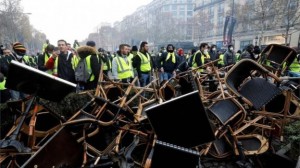from BBC,
11/16/18:
Police in Paris have used tear gas and water cannon to disperse protesters, in a second weekend of demonstrations sparked by rising fuel prices.

Violence erupted on the Champs-Elysées as protesters tried to get through a security cordon around sensitive sites.
About 5,000 protesters had converged on the avenue. Dozens of people were arrested after clashing with police.
Organisers of the "yellow vest" movement billed the latest protests as "act two" in their rolling campaign.
More than 100,000 took part in Saturday's protests across the country. They passed off largely peacefully - except in the capital, where 8,000 demonstrators gathered.
Not just about fuel
The spark for the protest is clear, but there's not much that unites the "yellow vests" beyond their high-visibility gear and their anger at rising taxes and living costs.
In a country where protests are often tightly managed by one political party or trade union, this is a movement with no recognised national leader, no formal structure or affiliation, which unites voters of all ages, from the far-left, the far-right, even those who once supported President Macron.
Their new co-operation is a sign that Mr Macron has failed to restore their faith in politicians, and that deep divisions remain. These are not France's most marginalised citizens, but those who say they struggle even while working, who feel they're bearing the brunt of France's economic problems, while businesses and the rich get tax breaks.
The government has blamed ultra-right gangs for the violence in Paris, but there are many peaceful citizens - both at the barricades and at home - who support the movement too.
Its diversity and democracy has been its strength so far, but also makes its ultimate vision unclear, and its membership hard to control.
Why wear yellow vests?
All drivers in France have to carry the vests in their cars as part of safety equipment for use in a breakdown.
Along with the familiar red reflective triangle which must be placed behind a broken-down vehicle on the side of a road, the high-visibility vest - or "gilet jaune" - must be worn by the driver outside the car.
Failure to wear the vest after a breakdown or accident can result in a €135 (£120; $153) fine under a law introduced in 2008.
More From BBC:






